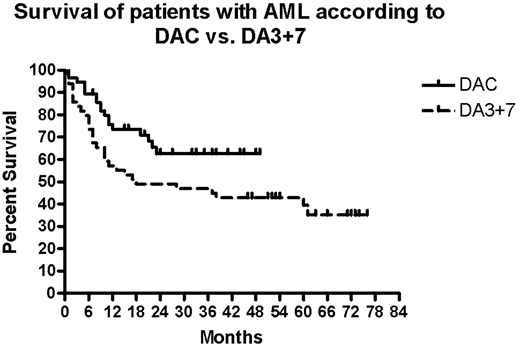Abstract
Background: Polish Adult Leukemia group demonstrated that addition of cladribine to standard daunorubicin + cytarabine (DAC) induction chemotherapy for acute myeloid leukaemia (AML) increases remission rate and prolongs overall survival. The approach was subsequently included in NCCN guidelines. At University Medical Centre Ljubljana, Slovenia we started using DAC induction regimen in May 2014 for all patients up to 60 years of age, eligible for intensive chemotherapy. We compared the outcome of patients treated with DA3+7 (in use from January 2012 until April 2014) with the outcome of patients treated with DAC in the period from May 2014 to December 2017.
Methods: We retrospectively analyzed all consecutive patients diagnosed with AML between January 2012 and December 2017, aged 60 or less, who were eligible for intensive chemotherapy according to ECOG performance status, echocardiography and spirometry results. Exclusion criteria were severe organ impairment and acute promyelocytic leukaemia. The induction regimen in the period January 2012 -April 2014 consisted of daunorubicin 60 mg/m2 on days 1,3 and 5 and continuous infusion of cytarabine 200 mg/m2 from day 1 to 7 (DA3+7) while in the period May 2014 - December 2017 cladribine 5 mg/m2 in a 3-hour infusion on days 1 through 5 was added to DA3+7. Consolidation treatment was the same for both groups and consisted of 2 or 3 courses of cytarabine. Eligible patients with unfavorable characteristics (monosomal /complex kariotype, FLT3 ITD or KMT2A rearrangements, therapy-related AML) proceeded to alogenic bone marrow transplantation (BMT). Patients who did not achieve remission after induction chemotherapy received rescue chemotherapy and also proceeded to alogenic BMT. The efficacy of induction treatment was assessed by bone marrow aspiration in the aplasia between days 7 and 10 after the last day of induction chemotherapy, and before the first consolidation therapy.
Results: 50 patients with AML (27 women, 23 men) were treated with DA3+7. 58 patients (31 women, 27 men) were treated with DAC. There were no significant differences in the median age of the patients in both groups (54,4 years in the DA group vs 54,5 years in the DAC group; p=0,853). There were also no significant differences in the proportion of patients with unfavorable cytogenetics or therapy-related AML (50% in the DA group vs 51,7% in the DAC group; p= 0,858). Remission after induction chemotherapy was achieved in a significantly higher proportion of patients in the DAC group (47/58= 81,0%) compared to the DA group (30/50 =60%; p=0,016). Survival was significantly higher in the DAC group compared to the DA group (p=0,034) with a median survival of 18 months in the DA group, while in the DAC group the median survival was not reached. No diferences in toxicity between the DA and DAC regimen were observed.
Conclusions: We confirmed results from other research groups by demonstrating improved remisssion induction rate and improved overall survival of AML patients aged 60 years or less treated with DAC induction compared to the standard DA3+7 induction chemotherapy. For evaluating the long-term overall survival further follow up is needed.
No relevant conflicts of interest to declare.
Author notes
Asterisk with author names denotes non-ASH members.


This feature is available to Subscribers Only
Sign In or Create an Account Close Modal